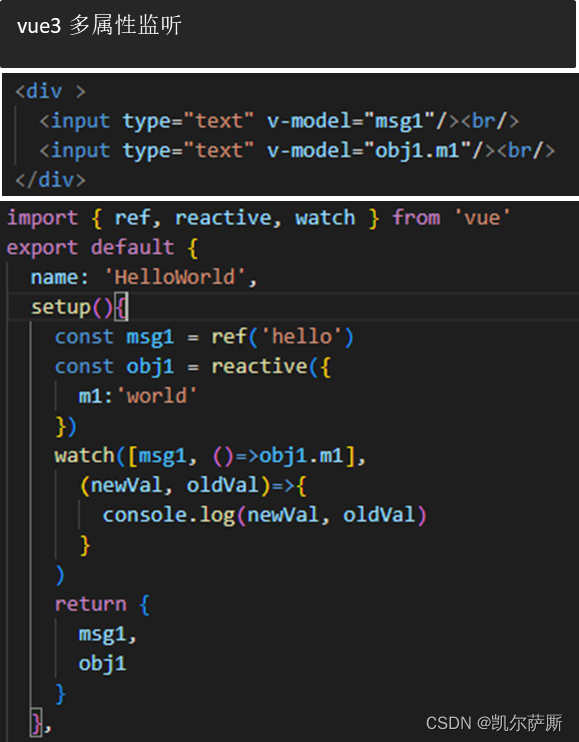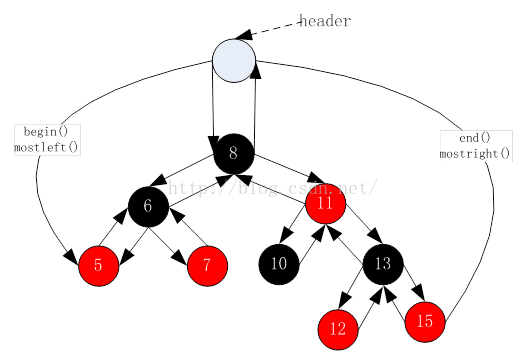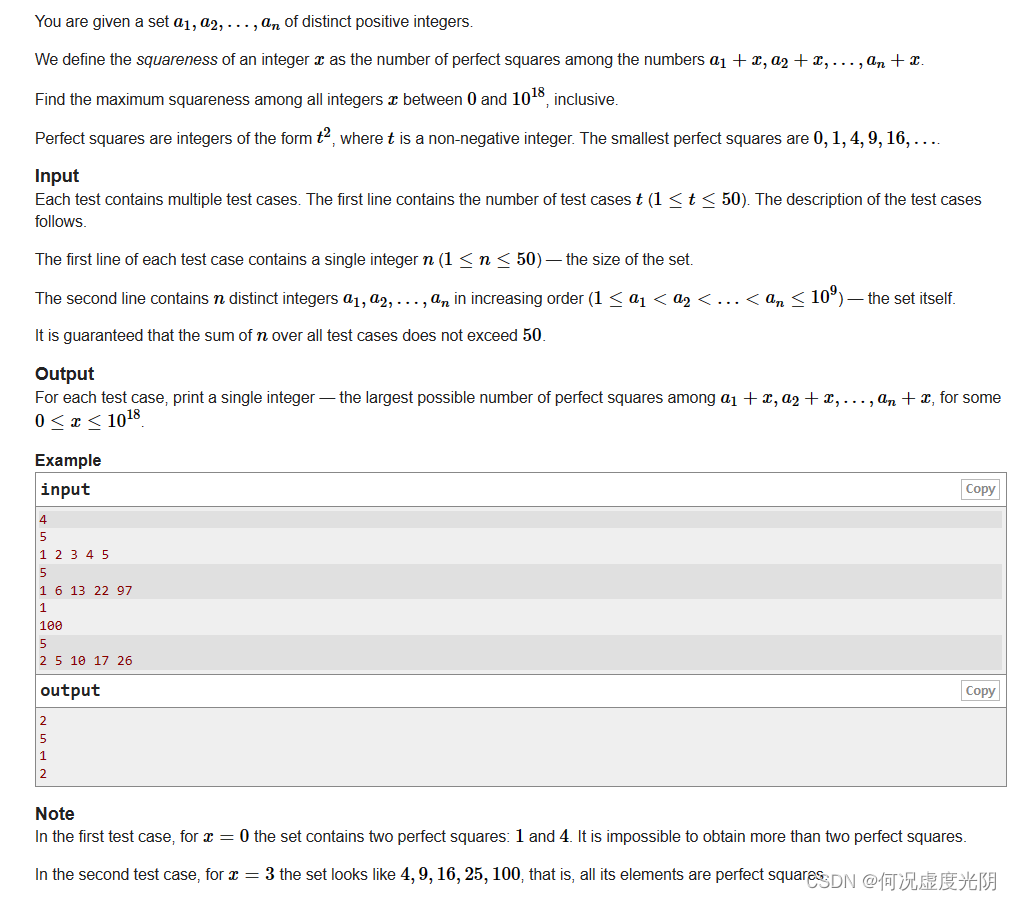参考链接:https://www.bilibili.com/video/BV1et411b73Z/p=237&spm_id_from=pageDriver&vd_source=b4d9cee68649c8adcb1e266f7147cd5c
4 STL- 函数对象
4.1 函数对象
4.1.1 函数对象概念
概念:
重载函数调用操作符的类,其对象常称为函数对象
函数对象使用重载的()时,行为类似函数调用,也叫仿函数
本质:
函数对象(仿函数)是一个类,不是一个函数
4.1.2 函数对象使用
特点:
函数对象在使用时,可以像普通函数那样调用, 可以有参数,可以有返回值
函数对象超出普通函数的概念,函数对象可以有自己的状态
函数对象可以作为参数传递
demo65:
#include<iostream>
#include<string>
using namespace std;
//1、函数对象在使用时,可以像普通函数那样调用, 可以有参数,可以有返回值
class MyAdd
{
public:
int operator()(int v1, int v2)
{
return v1 + v2;
}
};
void test01()
{
MyAdd myAdd;
cout << myAdd(10, 10) << endl;
}
//2、函数对象可以有自己的状态
class MyPrint
{
public:
MyPrint()
{
count = 0;
}
void operator()(string test)
{
cout << test << endl;
count++; //统计使用次数
}
int count; //内部自己的状态
};
void test02()
{
MyPrint myPrint;
myPrint("hello world");
myPrint("hello world");
myPrint("hello world");
cout << "myPrint调用次数为: " << myPrint.count << endl;
}
//3、函数对象可以作为参数传递
void doPrint(MyPrint& mp, string test)
{
mp(test);
}
void test03()
{
MyPrint myPrint;
doPrint(myPrint, "Hello C++");
}
int main()
{
test01();
test02();
test03();
system("pause");
return 0;
}
20
hello world
hello world
hello world
myPrint调用次数为: 3
Hello C++
总结:
仿函数写法非常灵活,可以作为参数进行传递。
4.2 谓词
4.2.1 谓词概念
概念:
返回bool类型的仿函数称为谓词
如果operator()接受一个参数,那么叫做一元谓词
如果operator()接受两个参数,那么叫做二元谓词
4.2.2 一元谓词
demo66:
#include<iostream>
#include<string>
using namespace std;
#include <vector>
#include <algorithm>
//1.一元谓词
struct GreaterFive {
bool operator()(int val) {
return val > 5;
}
};
void test01() {
vector<int> v;
for (int i = 0; i < 10; i++)
{
v.push_back(i);
}
//查找容器中 有没有大于5的数字
//GreaterFive() 匿名函数对象
vector<int>::iterator it = find_if(v.begin(), v.end(), GreaterFive());
if (it == v.end()) {
cout << "没找到!" << endl;
}
else {
cout << "找到:" << *it << endl;
}
}
int main()
{
test01();
system("pause");
return 0;
}
找到:6
总结:参数只有一个的谓词,称为一元谓词
4.2.3 二元谓词
demo67:
#include<iostream>
#include<string>
using namespace std;
#include <vector>
#include <algorithm>
//二元谓词
class MyCompare
{
public:
bool operator()(int num1, int num2)
{
return num1 > num2;
}
};
void test01()
{
vector<int> v;
v.push_back(10);
v.push_back(40);
v.push_back(20);
v.push_back(30);
v.push_back(50);
//默认从小到大
sort(v.begin(), v.end());
for (vector<int>::iterator it = v.begin(); it != v.end(); it++)
{
cout << *it << " ";
}
cout << endl;
cout << "----------------------------" << endl;
//使用函数对象改变算法策略,排序从大到小
sort(v.begin(), v.end(), MyCompare());
for (vector<int>::iterator it = v.begin(); it != v.end(); it++)
{
cout << *it << " ";
}
cout << endl;
}
int main()
{
test01();
system("pause");
return 0;
}
10 20 30 40 50
----------------------------
50 40 30 20 10
总结:参数只有两个的谓词,称为二元谓词
4.3 内建函数对象
4.3.1 内建函数对象意义
概念:
STL内建了一些函数对象
分类:
算术仿函数
关系仿函数
逻辑仿函数
用法:
这些仿函数所产生的对象,用法和一般函数完全相同
使用内建函数对象,需要引入头文件 #include<functional>
4.3.2 算术仿函数
功能描述:
实现四则运算
其中negate是一元运算,其他都是二元运算
仿函数原型:
template<class T> T plus<T> //加法仿函数
template<class T> T minus<T> //减法仿函数
template<class T> T multiplies<T> //乘法仿函数
template<class T> T divides<T> //除法仿函数
template<class T> T modulus<T> //取模仿函数
template<class T> T negate<T> //取反仿函数
demo68:
#include<iostream>
#include<string>
using namespace std;
#include <functional>
//negate
void test01()
{
negate<int> n;
cout << n(50) << endl;
}
//plus
void test02()
{
plus<int> p;
cout << p(10, 20) << endl;
}
int main()
{
test01();
test02();
system("pause");
return 0;
}
-50
30
总结:使用内建函数对象时,需要引入头文件 #include <functional>
4.3.3 关系仿函数
功能描述:
实现关系对比
仿函数原型:
template<class T> bool equal_to<T> //等于
template<class T> bool not_equal_to<T> //不等于
template<class T> bool greater<T> //大于
template<class T> bool greater_equal<T> //大于等于
template<class T> bool less<T> //小于
template<class T> bool less_equal<T> //小于等于
demo69:
#include<iostream>
#include<string>
using namespace std;
#include <functional>
#include <vector>
#include <algorithm>
//大于 greater
class MyCompare
{
public:
bool operator()(int v1, int v2)
{
return v1 > v2;
}
};
void test01()
{
vector<int> v;
v.push_back(10);
v.push_back(30);
v.push_back(50);
v.push_back(40);
v.push_back(20);
for (vector<int>::iterator it = v.begin(); it != v.end(); it++) {
cout << *it << " ";
}
cout << endl;
//自己实现仿函数
//sort(v.begin(), v.end(), MyCompare());
//STL内建仿函数 大于仿函数
sort(v.begin(), v.end(), greater<int>());
for (vector<int>::iterator it = v.begin(); it != v.end(); it++) {
cout << *it << " ";
}
cout << endl;
}
int main()
{
test01();
system("pause");
return 0;
}
10 30 50 40 20
50 40 30 20 10
总结:关系仿函数中最常用的就是greater<>大于
4.3.4 逻辑仿函数
功能描述:
实现逻辑运算
函数原型:
template<class T> bool logical_and<T> //逻辑与
template<class T> bool logical_or<T> //逻辑或
template<class T> bool logical_not<T> //逻辑非
demo70:
#include<iostream>
#include<string>
using namespace std;
#include <functional>
#include <vector>
#include <algorithm>
void test01()
{
vector<bool> v;
v.push_back(true);
v.push_back(false);
v.push_back(true);
v.push_back(false);
for (vector<bool>::iterator it = v.begin(); it != v.end(); it++)
{
cout << *it << " ";
}
cout << endl;
//逻辑非 将v容器搬运到v2中,并执行逻辑非运算
vector<bool> v2;
v2.resize(v.size()); //提前开辟空间
transform(v.begin(), v.end(), v2.begin(), logical_not<bool>()); //搬运
for (vector<bool>::iterator it = v2.begin(); it != v2.end(); it++)
{
cout << *it << " ";
}
cout << endl;
}
int main()
{
test01();
system("pause");
return 0;
}
1 0 1 0
0 1 0 1
总结:逻辑仿函数实际应用较少,了解即可
5 STL- 常用算法
概述:
算法主要是由头文件<algorithm> <functional> <numeric> 组成。
<algorithm> 是所有STL头文件中最大的一个,范围涉及到比较、 交换、查找、遍历操作、复制、修改等等
<numeric> 体积很小,只包括几个在序列上面进行简单数学运算的模板函数
<functional> 定义了一些模板类,用以声明函数对象。
5.1 常用遍历算法
学习目标:
掌握常用的遍历算法
算法简介:
for_each //遍历容器
transform //搬运容器到另一个容器中
5.1.1 for_each
功能描述:
实现遍历容器
函数原型:
for_each(iterator beg, iterator end, _func);
// 遍历算法 遍历容器元素
// beg 开始迭代器
// end 结束迭代器
// _func 函数或者函数对象
demo71:
#include<iostream>
#include<string>
using namespace std;
#include <vector>
#include <algorithm>
//普通函数
void print01(int val)
{
cout << val << " ";
}
//函数对象
class print02
{
public:
void operator()(int val)
{
cout << val << " ";
}
};
//for_each算法基本用法
void test01() {
vector<int> v;
for (int i = 0; i < 10; i++)
{
v.push_back(i);
}
//遍历算法
for_each(v.begin(), v.end(), print01);
cout << endl;
for_each(v.begin(), v.end(), print02());
cout << endl;
}
int main()
{
test01();
system("pause");
return 0;
}
0 1 2 3 4 5 6 7 8 9
0 1 2 3 4 5 6 7 8 9
总结:for_each在实际开发中是最常用遍历算法,需要熟练掌握
5.1.2 transform
功能描述:
搬运容器到另一个容器中
函数原型:
transform(iterator beg1, iterator end1, iterator beg2, _func);
//beg1 源容器开始迭代器
//end1 源容器结束迭代器
//beg2 目标容器开始迭代器
//_func 函数或者函数对象
demo72:
#include<iostream>
#include<string>
using namespace std;
#include <vector>
#include <algorithm>
//常用遍历算法 搬运 transform
class TransForm
{
public:
int operator()(int val)
{
return val;
}
};
class MyPrint
{
public:
void operator()(int val)
{
cout << val << " ";
}
};
void test01()
{
vector<int>v;
for (int i = 0; i < 10; i++)
{
v.push_back(i);
}
vector<int>vTarget; //目标容器
vTarget.resize(v.size()); // 目标容器需要提前开辟空间
transform(v.begin(), v.end(), vTarget.begin(), TransForm());
for_each(vTarget.begin(), vTarget.end(), MyPrint());
}
int main()
{
test01();
system("pause");
return 0;
}
0 1 2 3 4 5 6 7 8 9 请
总结: 搬运的目标容器必须要提前开辟空间,否则无法正常搬运
5.2 常用查找算法
学习目标:
掌握常用的查找算法
算法简介:
find //查找元素
find_if //按条件查找元素
adjacent_find //查找相邻重复元素
binary_search //二分查找法
count //统计元素个数
count_if //按条件统计元素个数
5.2.1 find
功能描述:
查找指定元素,找到返回指定元素的迭代器,找不到返回结束迭代器end()
函数原型:
find(iterator beg, iterator end, value);
// 按值查找元素,找到返回指定位置迭代器,找不到返回结束迭代器位置
// beg 开始迭代器
// end 结束迭代器
// value 查找的元素
demo73:
#include<iostream>
#include<string>
using namespace std;
#include <vector>
#include <algorithm>
//查找 内置数据类型
void test01() {
vector<int> v;
for (int i = 0; i < 10; i++) {
v.push_back(i + 1);
}
//查找容器中是否有 5 这个元素
vector<int>::iterator it = find(v.begin(), v.end(), 5);
if (it == v.end())
{
cout << "没有找到!" << endl;
}
else
{
cout << "找到:" << *it << endl;
}
}
//查找 自定义数据类型
class Person {
public:
Person(string name, int age)
{
this->m_Name = name;
this->m_Age = age;
}
//重载== 让底层find知道如何对比Person数据类型
bool operator==(const Person & p)
{
if (this->m_Name == p.m_Name && this->m_Age == p.m_Age)
{
return true;
}
return false;
}
public:
string m_Name;
int m_Age;
};
void test02() {
vector<Person> v;
//创建数据
Person p1("aaa", 10);
Person p2("bbb", 20);
Person p3("ccc", 30);
Person p4("ddd", 40);
v.push_back(p1);
v.push_back(p2);
v.push_back(p3);
v.push_back(p4);
Person pp("bbb", 20);
vector<Person>::iterator it = find(v.begin(), v.end(), pp);
if (it == v.end())
{
cout << "没有找到!" << endl;
}
else
{
cout << "找到姓名:" << it->m_Name << " 年龄: " << it->m_Age << endl;
}
}
int main()
{
test01();
test02();
system("pause");
return 0;
}
找到:5
找到姓名:bbb 年龄: 20
总结: 利用find可以在容器中找指定的元素,返回值是迭代器
5.2.2 find_if
功能描述:
按条件查找元素
函数原型:
find_if(iterator beg, iterator end, _Pred);
// 按值查找元素,找到返回指定位置迭代器,找不到返回结束迭代器位置
// beg 开始迭代器
// end 结束迭代器
// _Pred 函数或者谓词(返回bool类型的仿函数)
demo74:
#include<iostream>
#include<string>
using namespace std;
#include <vector>
#include <algorithm>
//内置数据类型
class GreaterFive
{
public:
bool operator()(int val)
{
return val > 5;
}
};
void test01() {
vector<int> v;
for (int i = 0; i < 10; i++) {
v.push_back(i + 1);
}
vector<int>::iterator it = find_if(v.begin(), v.end(), GreaterFive());
if (it == v.end()) {
cout << "没有找到!" << endl;
}
else {
cout << "找到大于5的数字:" << *it << endl;
}
}
//自定义数据类型
class Person {
public:
Person(string name, int age)
{
this->m_Name = name;
this->m_Age = age;
}
public:
string m_Name;
int m_Age;
};
class Greater20
{
public:
bool operator()(Person& p)
{
return p.m_Age > 20;
}
};
void test02() {
vector<Person> v;
//创建数据
Person p1("aaa", 10);
Person p2("bbb", 20);
Person p3("ccc", 30);
Person p4("ddd", 40);
v.push_back(p1);
v.push_back(p2);
v.push_back(p3);
v.push_back(p4);
vector<Person>::iterator it = find_if(v.begin(), v.end(), Greater20());
if (it == v.end())
{
cout << "没有找到!" << endl;
}
else
{
cout << "找到姓名:" << it->m_Name << " 年龄: " << it->m_Age << endl;
}
}
int main()
{
test01();
test02();
system("pause");
return 0;
}
找到大于5的数字:6
找到姓名:ccc 年龄: 30
总结:find_if按条件查找使查找更加灵活,提供的仿函数可以改变不同的策略
5.2.3 adjacent_find
功能描述:
查找相邻重复元素
函数原型:
adjacent_find(iterator beg, iterator end);
// 查找相邻重复元素,返回相邻元素的第一个位置的迭代器
// beg 开始迭代器
// end 结束迭代器
demo75:
#include<iostream>
#include<string>
using namespace std;
#include <vector>
#include <algorithm>
void test01()
{
vector<int> v;
v.push_back(1);
v.push_back(2);
v.push_back(5);
v.push_back(2);
v.push_back(4);
v.push_back(4);
v.push_back(3);
//查找相邻重复元素
vector<int>::iterator it = adjacent_find(v.begin(), v.end());
if (it == v.end()) {
cout << "找不到!" << endl;
}
else {
cout << "找到相邻重复元素为:" << *it << endl;
}
}
int main()
{
test01();
system("pause");
return 0;
}
找到相邻重复元素为:4
总结:面试题中如果出现查找相邻重复元素,记得用STL中的adjacent_find算法
5.2.4 binary_search
功能描述:
查找指定元素是否存在
函数原型:
bool binary_search(iterator beg, iterator end, value);
// 查找指定的元素,查到 返回true 否则false
// 注意: 在无序序列中不可用
// beg 开始迭代器
// end 结束迭代器
// value 查找的元素
demo76:
#include<iostream>
#include<string>
using namespace std;
#include <vector>
#include <algorithm>
void test01()
{
vector<int>v;
for (int i = 0; i < 10; i++)
{
v.push_back(i);
}
//二分查找
//注意:容器必须是有序的序列(升序)
//如果是无序序列,结果未知
bool ret = binary_search(v.begin(), v.end(), 2);
if (ret)
{
cout << "找到了" << endl;
}
else
{
cout << "未找到" << endl;
}
}
int main()
{
test01();
system("pause");
return 0;
}
找到了
总结:二分查找法查找效率很高,值得注意的是查找的容器中元素必须的有序序列
5.2.5 count
功能描述:
统计元素个数
函数原型:
count(iterator beg, iterator end, value);
// 统计元素出现次数
// beg 开始迭代器
// end 结束迭代器
// value 统计的元素
demo77:
#include<iostream>
#include<string>
using namespace std;
#include <vector>
#include <algorithm>
//内置数据类型
void test01()
{
vector<int> v;
v.push_back(10);
v.push_back(20);
v.push_back(40);
v.push_back(50);
v.push_back(30);
v.push_back(40);
v.push_back(40);
int num = count(v.begin(), v.end(), 40);
cout << "40的个数为: " << num << endl;
}
//自定义数据类型
class Person
{
public:
Person(string name, int age)
{
this->m_Name = name;
this->m_Age = age;
}
bool operator==(const Person& p)
{
if (this->m_Age == p.m_Age)
{
return true;
}
else
{
return false;
}
}
string m_Name;
int m_Age;
};
void test02()
{
vector<Person> v;
Person p1("刘备", 35);
Person p2("关羽", 35);
Person p3("张飞", 35);
Person p4("赵云", 30);
Person p5("曹操", 25);
v.push_back(p1);
v.push_back(p2);
v.push_back(p3);
v.push_back(p4);
v.push_back(p5);
Person p("诸葛亮", 35);
int num = count(v.begin(), v.end(), p);
cout << "和诸葛亮同岁数的人员个数为:" << num << endl;
}
int main()
{
test01();
test02();
system("pause");
return 0;
}
40的个数为: 3
和诸葛亮同岁数的人员个数为:3
总结: 统计自定义数据类型时候,需要配合重载 operator==
5.2.6 count_if
功能描述:
按条件统计元素个数
函数原型:
count_if(iterator beg, iterator end, _Pred);
// 按条件统计元素出现次数
// beg 开始迭代器
// end 结束迭代器
// _Pred 谓词
demo78:
#include<iostream>
#include<string>
using namespace std;
#include <vector>
#include <algorithm>
class Greater4
{
public:
bool operator()(int val)
{
return val >= 4;
}
};
//内置数据类型
void test01()
{
vector<int> v;
v.push_back(1);
v.push_back(2);
v.push_back(4);
v.push_back(5);
v.push_back(3);
v.push_back(4);
v.push_back(4);
int num = count_if(v.begin(), v.end(), Greater4());
cout << "大于等于4的个数为: " << num << endl;
}
//自定义数据类型
class Person
{
public:
Person(string name, int age)
{
this->m_Name = name;
this->m_Age = age;
}
string m_Name;
int m_Age;
};
class AgeLess35
{
public:
bool operator()(const Person& p)
{
return p.m_Age < 35;
}
};
void test02()
{
vector<Person> v;
Person p1("刘备", 35);
Person p2("关羽", 35);
Person p3("张飞", 35);
Person p4("赵云", 30);
Person p5("曹操", 25);
v.push_back(p1);
v.push_back(p2);
v.push_back(p3);
v.push_back(p4);
v.push_back(p5);
int num = count_if(v.begin(), v.end(), AgeLess35());
cout << "小于35岁的个数:" << num << endl;
}
int main()
{
test01();
test02();
system("pause");
return 0;
}
大于等于4的个数为: 4
小于35岁的个数:2
总结:按值统计用count,按条件统计用count_if
5.3 常用排序算法
学习目标:
掌握常用的排序算法
算法简介:
sort //对容器内元素进行排序
random_shuffle //洗牌 指定范围内的元素随机调整次序
merge // 容器元素合并,并存储到另一容器中
reverse // 反转指定范围的元素
5.3.1 sort
功能描述:
对容器内元素进行排序
函数原型:
sort(iterator beg, iterator end, _Pred);
// 按值查找元素,找到返回指定位置迭代器,找不到返回结束迭代器位置
// beg 开始迭代器
// end 结束迭代器
// _Pred 谓词
demo79:
#include<iostream>
#include<string>
using namespace std;
#include <vector>
#include <algorithm>
#include<functional>
void myPrint(int val)
{
cout << val << " ";
}
void test01() {
vector<int> v;
v.push_back(10);
v.push_back(30);
v.push_back(50);
v.push_back(20);
v.push_back(40);
//sort默认从小到大排序
sort(v.begin(), v.end());
for_each(v.begin(), v.end(), myPrint);
cout << endl;
//从大到小排序
sort(v.begin(), v.end(), greater<int>());
for_each(v.begin(), v.end(), myPrint);
cout << endl;
}
int main()
{
test01();
system("pause");
return 0;
}
10 20 30 40 50
50 40 30 20 10
总结:sort属于开发中最常用的算法之一,需熟练掌握
5.3.2 random_shuffle
功能描述:
洗牌 指定范围内的元素随机调整次序
函数原型:
random_shuffle(iterator beg, iterator end);
// 指定范围内的元素随机调整次序
// beg 开始迭代器
// end 结束迭代器
demo80:
#include<iostream>
#include<string>
using namespace std;
#include <vector>
#include <algorithm>
#include<ctime>
class myPrint
{
public:
void operator()(int val)
{
cout << val << " ";
}
};
void test01()
{
srand((unsigned int)time(NULL));
vector<int> v;
for (int i = 0; i < 10; i++)
{
v.push_back(i);
}
for_each(v.begin(), v.end(), myPrint());
cout << endl;
//打乱顺序
random_shuffle(v.begin(), v.end());
for_each(v.begin(), v.end(), myPrint());
cout << endl;
}
int main()
{
test01();
system("pause");
return 0;
}
0 1 2 3 4 5 6 7 8 9
8 4 1 0 6 2 3 7 9 5
总结:random_shuffle洗牌算法比较实用,使用时记得加随机数种子
5.3.3 merge
功能描述:
两个容器元素合并,并存储到另一容器中
函数原型:
merge(iterator beg1, iterator end1, iterator beg2, iterator end2, iterator dest);
// 容器元素合并,并存储到另一容器中
// 注意: 两个容器必须是有序的
// beg1 容器1开始迭代器 // end1 容器1结束迭代器 // beg2 容器2开始迭代器 // end2 容器2结束迭代器 //
dest 目标容器开始迭代器
demo81:
#include<iostream>
#include<string>
using namespace std;
#include <vector>
#include <algorithm>
class myPrint
{
public:
void operator()(int val)
{
cout << val << " ";
}
};
void test01()
{
vector<int> v1;
vector<int> v2;
for (int i = 0; i < 10; i++)
{
v1.push_back(i);
v2.push_back(i + 1);
}
//目标容器
vector<int> vtarget;
vtarget.resize(v1.size() + v2.size()); //目标容器需要提前开辟空间
//合并 需要两个有序序列,而且顺序一致,比如均为升序
merge(v1.begin(), v1.end(), v2.begin(), v2.end(), vtarget.begin());
for_each(vtarget.begin(), vtarget.end(), myPrint());
cout << endl;
}
int main()
{
test01();
system("pause");
return 0;
}
0 1 1 2 2 3 3 4 4 5 5 6 6 7 7 8 8 9 9 10
总结:merge合并的两个容器必须的有序序列
5.3.4 reverse
功能描述:
将容器内元素进行反转
函数原型:
reverse(iterator beg, iterator end);
// 反转指定范围的元素
// beg 开始迭代器
// end 结束迭代器
demo82:
#include<iostream>
#include<string>
using namespace std;
#include <vector>
#include <algorithm>
class myPrint
{
public:
void operator()(int val)
{
cout << val << " ";
}
};
void test01()
{
vector<int> v;
v.push_back(10);
v.push_back(30);
v.push_back(50);
v.push_back(20);
v.push_back(40);
cout << "反转前: " << endl;
for_each(v.begin(), v.end(), myPrint());
cout << endl;
cout << "反转后: " << endl;
reverse(v.begin(), v.end());
for_each(v.begin(), v.end(), myPrint());
cout << endl;
}
int main()
{
test01();
system("pause");
return 0;
}
反转前:
10 30 50 20 40
反转后:
40 20 50 30 10
总结:reverse反转区间内元素,面试题可能涉及到
5.4 常用拷贝和替换算法
学习目标:
掌握常用的拷贝和替换算法
算法简介:
copy // 容器内指定范围的元素拷贝到另一容器中
replace // 将容器内指定范围的旧元素修改为新元素
replace_if // 容器内指定范围满足条件的元素替换为新元素
swap // 互换两个容器的元素
5.4.1 copy
功能描述:
容器内指定范围的元素拷贝到另一容器中
函数原型:
copy(iterator beg, iterator end, iterator dest);
// 按值查找元素,找到返回指定位置迭代器,找不到返回结束迭代器位置
// beg 开始迭代器
// end 结束迭代器
// dest 目标起始迭代器
demo83:
#include<iostream>
#include<string>
using namespace std;
#include <vector>
#include <algorithm>
class myPrint
{
public:
void operator()(int val)
{
cout << val << " ";
}
};
void test01()
{
vector<int> v1;
for (int i = 0; i < 10; i++) {
v1.push_back(i + 1);
}
vector<int> v2;
v2.resize(v1.size());
copy(v1.begin(), v1.end(), v2.begin());
for_each(v2.begin(), v2.end(), myPrint());
cout << endl;
}
int main()
{
test01();
system("pause");
return 0;
}
1 2 3 4 5 6 7 8 9 10
总结:利用copy算法在拷贝时,目标容器记得提前开辟空间
5.4.2 replace
功能描述:
将容器内指定范围的旧元素修改为新元素
函数原型:
replace(iterator beg, iterator end, oldvalue, newvalue);
// 将区间内旧元素 替换成 新元素
// beg 开始迭代器
// end 结束迭代器
// oldvalue 旧元素
// newvalue 新元素
demo84:
#include<iostream>
#include<string>
using namespace std;
#include <vector>
#include <algorithm>
class myPrint
{
public:
void operator()(int val)
{
cout << val << " ";
}
};
void test01()
{
vector<int> v;
v.push_back(20);
v.push_back(30);
v.push_back(20);
v.push_back(40);
v.push_back(50);
v.push_back(10);
v.push_back(20);
cout << "替换前:" << endl;
for_each(v.begin(), v.end(), myPrint());
cout << endl;
//将容器中的20 替换成 2000
cout << "替换后:" << endl;
replace(v.begin(), v.end(), 20, 2000);
for_each(v.begin(), v.end(), myPrint());
cout << endl;
}
int main()
{
test01();
system("pause");
return 0;
}
替换前:
20 30 20 40 50 10 20
替换后:
2000 30 2000 40 50 10 2000
总结:replace会替换区间内满足条件的元素
5.4.3 replace_if
功能描述:
将区间内满足条件的元素,替换成指定元素
函数原型:
replace_if(iterator beg, iterator end, _pred, newvalue);
// 按条件替换元素,满足条件的替换成指定元素
// beg 开始迭代器
// end 结束迭代器
// _pred 谓词
// newvalue 替换的新元素
demo85:
#include<iostream>
#include<string>
using namespace std;
#include <vector>
#include <algorithm>
class myPrint
{
public:
void operator()(int val)
{
cout << val << " ";
}
};
class ReplaceGreater30
{
public:
bool operator()(int val)
{
return val >= 30;
}
};
void test01()
{
vector<int> v;
v.push_back(20);
v.push_back(30);
v.push_back(20);
v.push_back(40);
v.push_back(50);
v.push_back(10);
v.push_back(20);
cout << "替换前:" << endl;
for_each(v.begin(), v.end(), myPrint());
cout << endl;
//将容器中大于等于的30 替换成 3000
cout << "替换后:" << endl;
replace_if(v.begin(), v.end(), ReplaceGreater30(), 3000);
for_each(v.begin(), v.end(), myPrint());
cout << endl;
}
int main()
{
test01();
system("pause");
return 0;
}
替换前:
20 30 20 40 50 10 20
替换后:
20 3000 20 3000 3000 10 20
总结:replace_if按条件查找,可以利用仿函数灵活筛选满足的条件
5.4.4 swap
功能描述:
互换两个容器的元素
函数原型:
swap(container c1, container c2);
// 互换两个容器的元素
// c1容器1
// c2容器2
demo86:
#include<iostream>
#include<string>
using namespace std;
#include <vector>
#include <algorithm>
class myPrint
{
public:
void operator()(int val)
{
cout << val << " ";
}
};
void test01()
{
vector<int> v1;
vector<int> v2;
for (int i = 0; i < 10; i++) {
v1.push_back(i);
v2.push_back(i + 100);
}
cout << "交换前: " << endl;
for_each(v1.begin(), v1.end(), myPrint());
cout << endl;
for_each(v2.begin(), v2.end(), myPrint());
cout << endl;
cout << "-------------------" << endl;
cout << "交换后: " << endl;
swap(v1, v2);
for_each(v1.begin(), v1.end(), myPrint());
cout << endl;
for_each(v2.begin(), v2.end(), myPrint());
cout << endl;
}
int main()
{
test01();
system("pause");
return 0;
}
交换前:
0 1 2 3 4 5 6 7 8 9
100 101 102 103 104 105 106 107 108 109
-------------------
交换后:
100 101 102 103 104 105 106 107 108 109
0 1 2 3 4 5 6 7 8 9
总结:swap交换容器时,注意交换的容器要同种类型
5.5 常用算术生成算法
学习目标:
掌握常用的算术生成算法
注意:
算术生成算法属于小型算法,使用时包含的头文件为 #include <numeric>
算法简介:
accumulate // 计算容器元素累计总和
fill // 向容器中添加元素
5.5.1 accumulate
功能描述:
计算区间内 容器元素累计总和
函数原型:
accumulate(iterator beg, iterator end, value);
// 计算容器元素累计总和
// beg 开始迭代器
// end 结束迭代器
// value 起始值
demo87:
#include<iostream>
#include<string>
using namespace std;
#include <vector>
#include <numeric>
void test01()
{
vector<int> v;
for (int i = 0; i <= 100; i++) {
v.push_back(i);
}
//参数3 是起始累加值;如果改成1000,结果为6050
int total = accumulate(v.begin(), v.end(), 0);
cout << "total = " << total << endl;
}
int main()
{
test01();
system("pause");
return 0;
}
total = 5050
总结:accumulate使用时头文件注意是 numeric,这个算法很实用
5.5.2 fill
功能描述:
向容器中填充指定的元素
函数原型:
fill(iterator beg, iterator end, value);
// 向容器中填充元素
// beg 开始迭代器
// end 结束迭代器
// value 填充的值
demo88:
#include<iostream>
#include<string>
using namespace std;
#include <vector>
#include <numeric>
#include <algorithm>
class myPrint
{
public:
void operator()(int val)
{
cout << val << " ";
}
};
void test01()
{
vector<int> v;
v.resize(10);
//填充
fill(v.begin(), v.end(), 100);
for_each(v.begin(), v.end(), myPrint());
cout << endl;
}
int main()
{
test01();
system("pause");
return 0;
}
100 100 100 100 100 100 100 100 100 100
总结:利用fill可以将容器区间内元素填充为 指定的值
5.6 常用集合算法
学习目标:
掌握常用的集合算法
算法简介:
set_intersection // 求两个容器的交集
set_union // 求两个容器的并集
set_difference // 求两个容器的差集
5.6.1 set_intersection
功能描述:
求两个容器的交集
函数原型:
set_intersection(iterator beg1, iterator end1, iterator beg2, iterator end2, iterator dest);
// 求两个集合的交集
// 注意:两个集合必须是有序序列
// beg1 容器1开始迭代器 // end1 容器1结束迭代器 // beg2 容器2开始迭代器 // end2 容器2结束迭代器 //
dest 目标容器开始迭代器
demo89:
#include<iostream>
#include<string>
using namespace std;
#include <vector>
#include <numeric>
#include <algorithm>
class myPrint
{
public:
void operator()(int val)
{
cout << val << " ";
}
};
void test01()
{
vector<int> v1;
vector<int> v2;
for (int i = 0; i < 10; i++)
{
v1.push_back(i);
v2.push_back(i + 5);
}
vector<int> vTarget;
//取两个里面较小的值给目标容器开辟空间
vTarget.resize(min(v1.size(), v2.size())); //最特殊情况:大容器包含小容器
//返回目标容器的最后一个元素的迭代器地址
vector<int>::iterator itEnd =
set_intersection(v1.begin(), v1.end(), v2.begin(), v2.end(), vTarget.begin());
for_each(vTarget.begin(), itEnd, myPrint());
cout << endl;
cout << "如果用vTarget.end(),会返回整体的长度(其他用0 填充)"<< endl;
for_each(vTarget.begin(), vTarget.end(),myPrint());
cout << endl;
}
int main()
{
test01();
system("pause");
return 0;
}
5 6 7 8 9
如果用vTarget.end(),会返回整体的长度(其他用0 填充)
5 6 7 8 9 0 0 0 0 0
总结:
求交集的两个集合必须的有序序列
目标容器开辟空间需要从两个容器中取小值
set_intersection返回值既是交集中最后一个元素的位置
5.6.2 set_union
功能描述:
求两个集合的并集
函数原型:
set_union(iterator beg1, iterator end1, iterator beg2, iterator end2, iterator dest);
// 求两个集合的并集
// 注意:两个集合必须是有序序列
// beg1 容器1开始迭代器 // end1 容器1结束迭代器 // beg2 容器2开始迭代器 // end2 容器2结束迭代器 //
dest 目标容器开始迭代器
demo90:
#include<iostream>
#include<string>
using namespace std;
#include <vector>
#include <numeric>
#include <algorithm>
class myPrint
{
public:
void operator()(int val)
{
cout << val << " ";
}
};
void test01()
{
vector<int> v1;
vector<int> v2;
for (int i = 0; i < 10; i++) {
v1.push_back(i);
v2.push_back(i + 5);
}
vector<int> vTarget;
//取两个容器的和给目标容器开辟空间
vTarget.resize(v1.size() + v2.size()); //最特殊情况:两个容器没有交集
//返回目标容器的最后一个元素的迭代器地址
vector<int>::iterator itEnd =
set_union(v1.begin(), v1.end(), v2.begin(), v2.end(), vTarget.begin());
for_each(vTarget.begin(), itEnd, myPrint());
cout << endl;
}
int main()
{
test01();
system("pause");
return 0;
}
0 1 2 3 4 5 6 7 8 9 10 11 12 13 14
总结:
求并集的两个集合必须的有序序列
目标容器开辟空间需要两个容器相加
set_union返回值既是并集中最后一个元素的位置
5.6.3 set_difference
功能描述:
求两个集合的差集
函数原型:
set_difference(iterator beg1, iterator end1, iterator beg2, iterator end2, iterator dest);
// 求两个集合的差集
// 注意:两个集合必须是有序序列
// beg1 容器1开始迭代器 // end1 容器1结束迭代器 // beg2 容器2开始迭代器 // end2 容器2结束迭代器 //
dest 目标容器开始迭代器
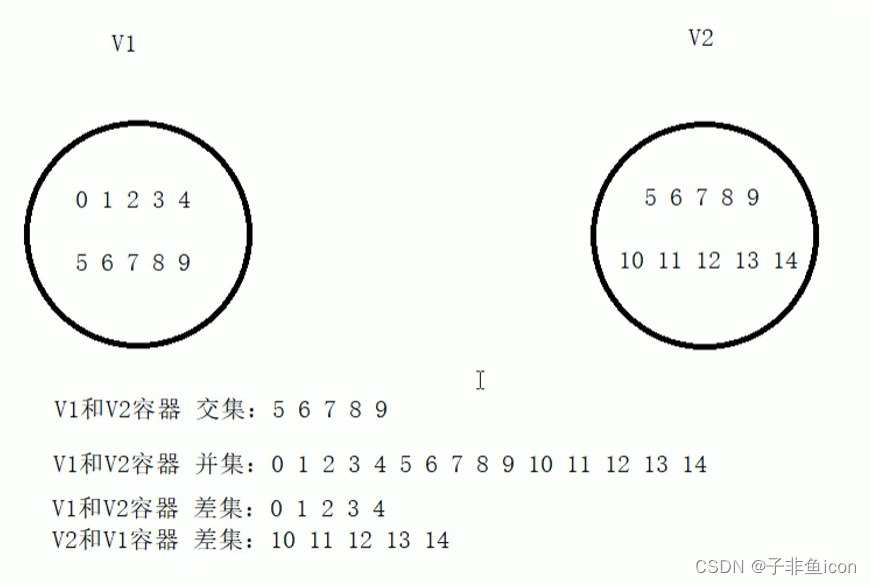
demo91:
#include<iostream>
#include<string>
using namespace std;
#include <vector>
#include <numeric>
#include <algorithm>
class myPrint
{
public:
void operator()(int val)
{
cout << val << " ";
}
};
void test01()
{
vector<int> v1;
vector<int> v2;
for (int i = 0; i < 10; i++) {
v1.push_back(i);
v2.push_back(i + 5);
}
vector<int> vTarget;
//取两个里面较大的值给目标容器开辟空间
vTarget.resize(max(v1.size(), v2.size())); //最特殊情况:两容器无交集
//返回目标容器的最后一个元素的迭代器地址
cout << "v1与v2的差集为: " << endl;
vector<int>::iterator itEnd =
set_difference(v1.begin(), v1.end(), v2.begin(), v2.end(), vTarget.begin());
for_each(vTarget.begin(), itEnd, myPrint());
cout << endl;
cout << "v2与v1的差集为: " << endl;
itEnd = set_difference(v2.begin(), v2.end(), v1.begin(), v1.end(), vTarget.begin());
for_each(vTarget.begin(), itEnd, myPrint());
cout << endl;
}
int main()
{
test01();
system("pause");
return 0;
}
v1与v2的差集为:
0 1 2 3 4
v2与v1的差集为:
10 11 12 13 14
总结:
求差集的两个集合必须的有序序列
目标容器开辟空间需要从两个容器取较大值
set_difference返回值既是差集中最后一个元素的位置
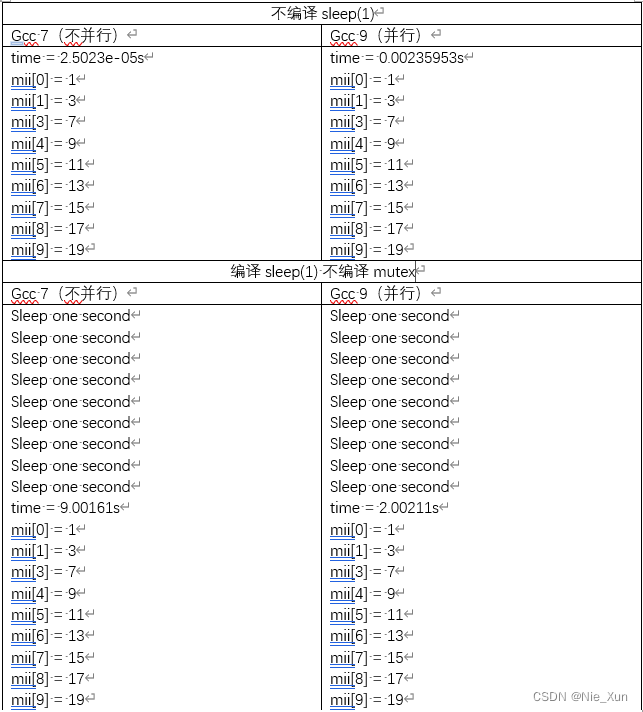
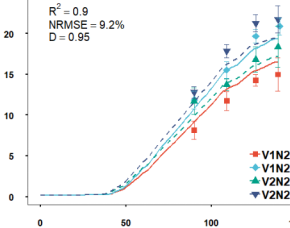

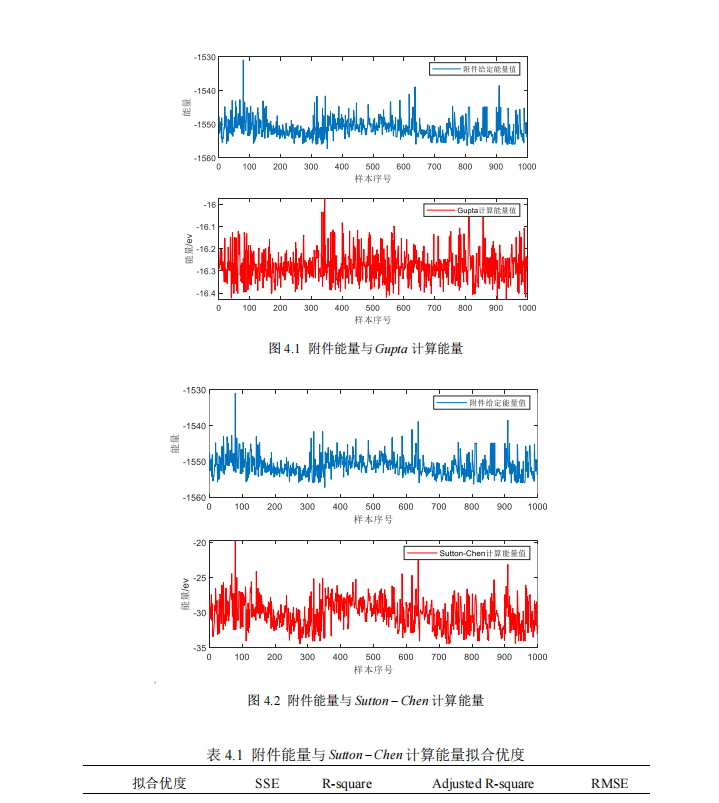
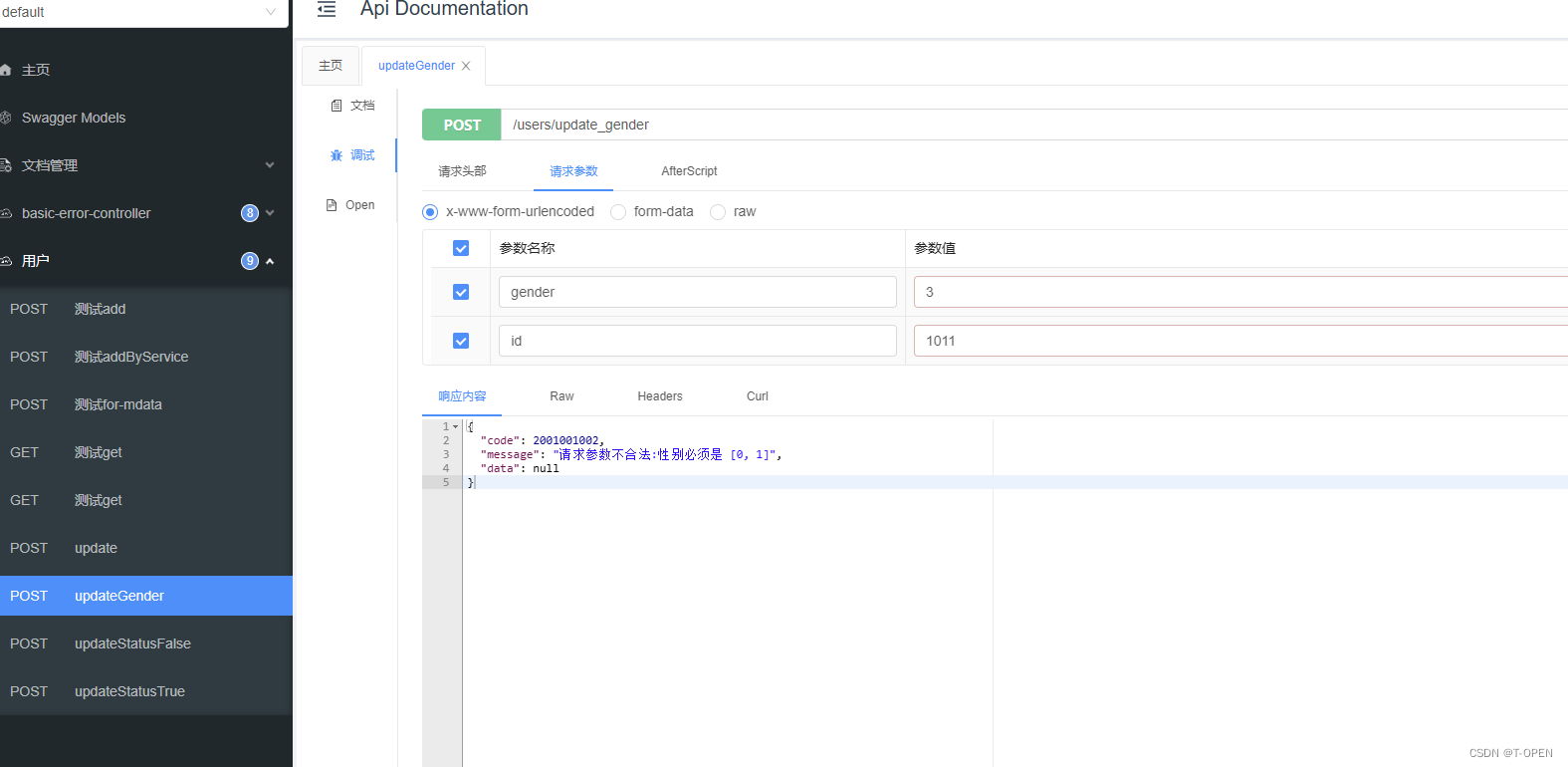
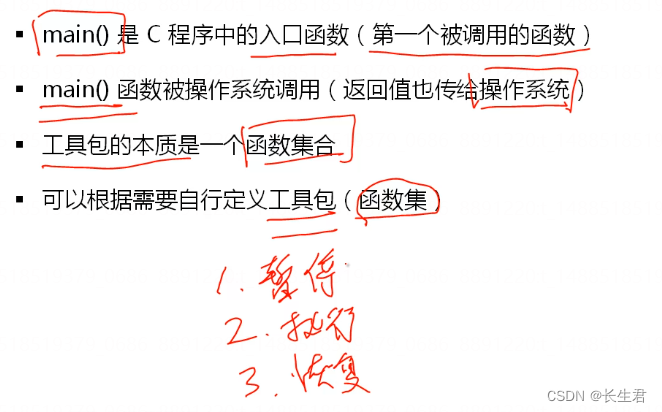








![运行Spring Boot项目时[ java: 错误: 不支持发行版本 17 ]](https://img-blog.csdnimg.cn/ff6316686e8c4b2ab3c1f8933984eed7.png)
